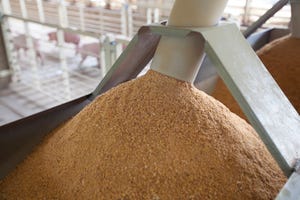“If you are going to be in the business of pork production, you need to start thinking today what would happen if antibiotic growth promotants or control/prevention uses were taken out,” declares James McKean, DVM, associate director of the Iowa Pork Industry Center in Ames, IA
June 16, 2011

Whether it’s through legislation or regulation from the Food and Drug Administration (FDA), changes are definitely coming in how pork producers will be able to use antimicrobials in food-producing animals.
“If you are going to be in the business of pork production, you need to start thinking today what would happen if antibiotic growth promotants or control/prevention uses were taken out,” declares James McKean, DVM, associate director of the Iowa Pork Industry Center in Ames, IA.
Focusing on the postweaning stage of production, McKean suggests that limitations on the use of antibiotics in nursery pigs would result in more gut infections and related bacterial problems in young pigs and a rise in the incidence of chronic respiratory infections.
“So producers need to look at what diseases they know they have on their farms for which there are reasonably good vaccines for protection,” he suggests.
Then, producers need to inventory the diseases that can be effectively and economically controlled by treatment, because therapeutic use of antibiotics will be still allowed, he points out.
For animal health problems without a good vaccine, or reasonable ability to treat therapeutically, it’s time to start looking at how to get rid of them, he urges.
Two viruses, which are not affected by antimicrobials because they only work on bacteria, make for good examples. Vaccine appears to work exceptionally well against porcine circovirus type 2 (PCV2), while at the other end of the spectrum, vaccine has had less of an impact in effectively controlling porcine reproductive and respiratory syndrome (PRRS).
“PRRS suppresses the immune system, and so all of those secondary bacterial diseases that you are keeping under control would be more difficult with the loss of the routine use of antibiotics in grow-finish. That means now might be the time to start whittling away at that list,” McKean notes. Diseases like swine dysentery and Actinobacillus pleuropneumonia, which are costly and difficult to treat, also automatically make the list.
Strategic Health Planning
The secondary problems aren’t animal health challenges that you are going to solve tomorrow, he says. But set up a meeting with your swine veterinarian to hammer out a plan to evaluate the prevalence, cost and resources it might take, even in a multi-year strategy, to eliminate some bacterial disease concerns.
The potential loss of animal health products for some bacterial agents that are made worse by the presence of PRRS is all the more reason to eradicate the virus, McKean says. He is a member of a team that is developing a state PRRS pilot control and eradication project in Iowa County, IA.
Raising the weaning age from 21 to 28-plus days helps control gut infections, but requires more farrowing crates due to extended sow lactation periods. This restriction provides another reason for ramping up biosecurity to keep out the diseases you don’t have, McKean says.
Pig comfort or welfare also becomes an issue if access to proper animal health remedies is restricted.
Pressures Mount
Adopting those management changes becomes more crucial as pressures to limit the use of growth-promotant antibiotics increase.
One pressure comes from FDA’s Guidance Document 209, which recommends restrictions in the use of control/prevention and treatment drugs and more veterinary supervision. McKean says the agency specifies types of drug use that are important to remember in this discussion:
Medically important drugs are those that are important as therapeutics in humans (most veterinary antibiotics);
Judicious use is the use of drugs for treatment, control and prevention of animal diseases under prescribed rules;
Injudicious use is the use of drugs for all other animal drug usages;
Therapeutic drugs are those used to treat specific diseases; and
Subtherapeutic drugs are low-level animal drugs used for growth promotion and feed efficiency.
The guidance document lays out five factors for judicious drug use, the most difficult of which to meet is the indication that use must be linked to a specific disease agent.
In contrast, the routine use of antimicrobials in young, post-weaned pigs can offer a direct health benefit for control of low levels of a broad class of pathogens, McKean says.
Later in grow-finish, antimicrobials truly are beneficial for growth promotion and feed efficiency, especially important with $7/bu. corn, he says. “There is a reason why more producers are using antibiotics now in grow-finish than 10 years ago, and that is because a 5% improvement in feed efficiency on $7 corn is worth a whole lot more than a 5% improvement in feed efficiency on $2 corn.”
Legislation More Lethal
In stark contrast to FDA’s guidance document on antibiotics, which is advisory, proposed legislation recently reintroduced by Rep. Louise Slaughter (D-NY) (HR 965) would phase out all non-therapeutic use of medically important antibiotics in farm animals.
“As I read this bill, it would eliminate control and prevention uses, leaving treatment methods only,” McKean says. This legislation has garnered bipartisan support on both coasts from politicians who unwittingly believe the arguments that low-level drug use causes antibiotic resistance.
Recently, Slaughter has ranted about FDA’s revelation that 74% of antibiotics given to food animals are administered subtherapeutically through feed, 16% in the water, and only 3% through injections.
Read the National Pork Producers Council’s recent response here.
You May Also Like



